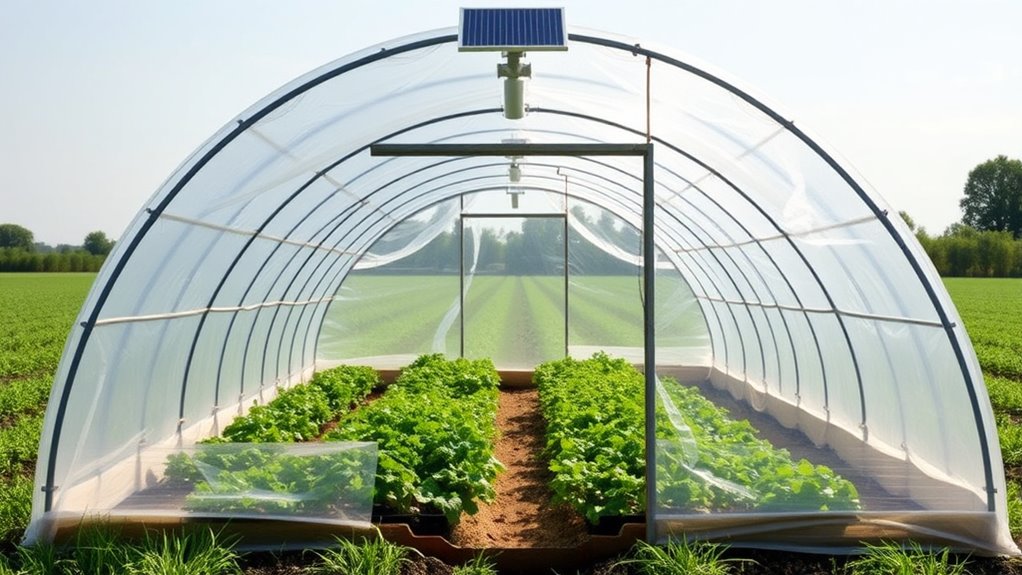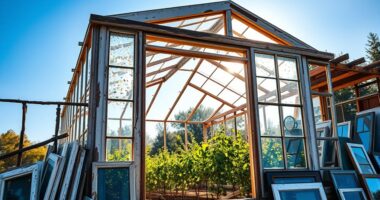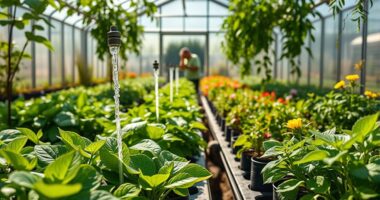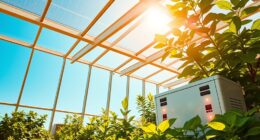To build an energy-efficient hoop house, focus on designing for natural airflow with strategically placed vents at the top and bottom to promote passive ventilation. Incorporate thermal mass, like water barrels or stone walls, to absorb heat during the day and release it at night. Insulate sides and ends to prevent heat loss, and orient the structure for maximum sunlight exposure. If you keep these passive strategies in mind, you’ll create a sustainable, cost-effective environment that minimizes energy use.
Key Takeaways
- Orient the hoop house southward to maximize sunlight exposure and enhance passive solar heating.
- Incorporate properly placed vents at the top and bottom to facilitate natural airflow and solar ventilation.
- Use thermal mass materials like water barrels or stone walls to absorb and store heat for nighttime warmth.
- Insulate sidewalls and ends with foam or insulating materials to minimize heat loss and improve energy efficiency.
- Utilize reflective surfaces and light-colored materials to improve heat absorption and distribute warmth evenly inside the structure.

Building an energy-efficient hoop house is a smart way to extend your growing season while minimizing energy costs. To achieve this, you should focus on passive heating and cooling strategies that harness natural energy flows. One effective approach is incorporating solar ventilation. During the day, sunlight heats the interior, causing warm air to rise and escape through strategically placed vents or openings at the top of the structure. This natural airflow pulls in cooler air from lower vents, creating a continuous cycle that helps regulate temperature without relying on electrical fans. Proper placement and sizing of these vents are vital; they should be positioned to maximize airflow while preventing drafts that could chill plants at night.
Harness natural airflow with strategic vents for energy-efficient temperature regulation.
Equally important is the use of thermal mass within your hoop house. Thermal mass refers to materials that absorb and store heat during the day and release it slowly at night, helping to stabilize indoor temperatures. You can add thermal mass by placing water barrels, concrete blocks, or stone walls inside the structure. During sunny days, these materials soak up heat, reducing temperature fluctuations and keeping the environment warmer when the sun goes down. When designing your hoop house, position these thermal mass elements where they’ll receive direct sunlight and be in contact with the interior air for maximum efficiency. This passive heating technique works best when paired with good insulation and strategic ventilation.
Incorporating solar ventilation and thermal mass isn’t complicated, but it requires thoughtful planning. For instance, use reflective materials or light-colored surfaces inside the hoop house to enhance heat absorption and distribution. Additionally, ensure your structure’s orientation maximizes sunlight exposure, ideally facing south if you’re in the northern hemisphere. This orientation boosts solar gain and works synergistically with your thermal mass to maintain a stable temperature. Insulation is another critical factor; consider insulating the sides and ends of your hoop house with foam or other insulating materials to prevent heat loss during cold nights. Combining these elements creates a self-regulating environment that reduces your reliance on supplemental heating or cooling, saving you energy and money.
Ultimately, building an energy-efficient hoop house means leveraging natural energy flows through solar ventilation and thermal mass. These passive systems work in harmony to keep your plants thriving year-round, even in cooler weather. With careful planning and implementation, you can create a sustainable, cost-effective growing environment that extends your growing season without the need for complex, energy-intensive systems. This approach not only benefits your plants but also promotes a greener, more environmentally friendly gardening practice.
Frequently Asked Questions
What Are the Best Materials for Hoop House Framing?
You should choose galvanized steel or PVC pipes for hoop house framing because they’re durable and resistant to rust. These materials provide stability for your structure, supporting effective hoop house ventilation and hoop house shading. Galvanized steel offers strength, while PVC is lightweight and easy to work with. Combining these with proper shading and ventilation ensures your hoop house stays energy-efficient and maintains ideal conditions for your plants.
How Can I Maximize Insulation Without Sacrificing Light?
Imagine your hoop house glowing with warm light, while insulation keeps the chill out. You can maximize insulation by installing thermal curtains that trap heat during cold nights and opening reflective panels during sunny days to bounce light inside without losing warmth. This combo creates a cozy environment, balancing ample sunlight and energy efficiency, so your plants thrive with less energy loss and more natural light, all year round.
What Are Cost-Effective Heating Options for Cold Climates?
You can save costs in cold climates by using solar thermal systems to harness sunlight for heating your hoop house. Additionally, compost heating offers an eco-friendly, budget-friendly option, as compost generates heat naturally as it decomposes. Combining these methods provides a sustainable, effective way to keep your hoop house warm without high energy bills, ensuring plants thrive even during chilly months.
How Do I Prevent Pests and Pests Entry?
To prevent pests from entering your hoop house, focus on pest exclusion by sealing all gaps, vents, and entry points with fine mesh or weather stripping. Use trap placement strategically near potential pest entry points to catch intruders early. Regularly inspect and maintain seals, and keep the area clean to minimize attractants. These steps work together to create an effective barrier, reducing pest issues and protecting your crops efficiently.
What Maintenance Is Required to Keep the Hoop House Energy-Efficient?
Think of your hoop house as a finely tuned engine that needs regular tuning. To keep it energy-efficient, you should monitor and adjust ventilation strategies seasonally, opening vents or adding shade as needed. Regularly check for drafts, seal leaks, and clean filters. Making seasonal adjustments ensures your hoop house runs smoothly year-round, conserving energy and maintaining ideal growing conditions. Consistent upkeep keeps your greenhouse thriving efficiently.
Conclusion
Now that you know how to build an energy-efficient hoop house, you’re well on your way to growing healthy plants year-round. Remember, a little extra effort upfront can pay off in big dividends later. Keep your focus on proper insulation and ventilation, and you’ll reap the rewards of a thriving, sustainable garden. Don’t let this project fall by the wayside—stick to your plan and watch your green thumb flourish!









